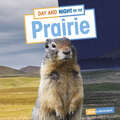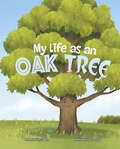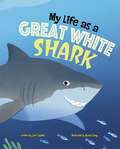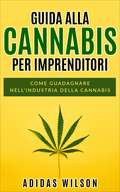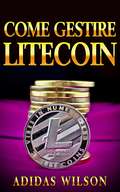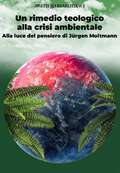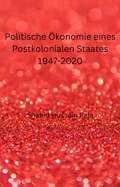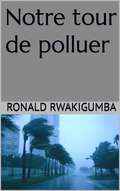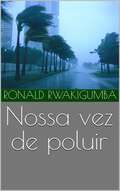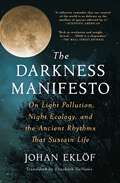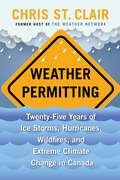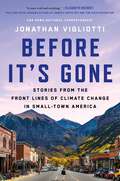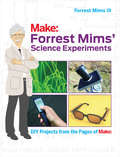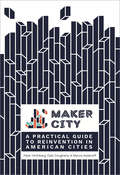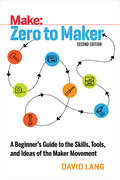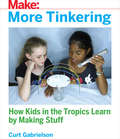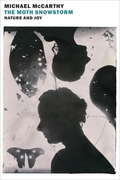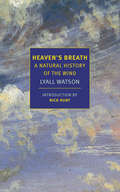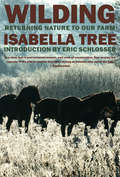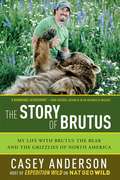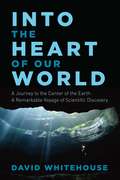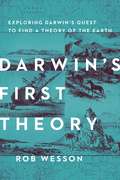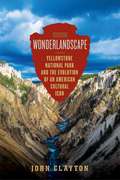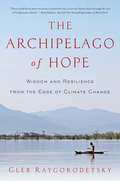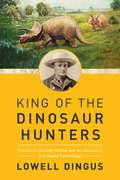- Table View
- List View
Day and Night on the Prairie (Habitat Days and Nights)
by Ellen LabrecqueSpend a day and night in the prairie! Learn about this grassy habitat through the exciting animals that call it home. Spot prairie dogs popping aboveground as morning sun floods a field. Join giant bison as they graze on grass. Stir up dust on a sunset sprint with antelope. After dark, stake out prey with a coyote in dense grass. What will tomorrow bring in the prairie?
My Life as an Oak Tree (My Life Cycle)
by John SazaklisHi, there! I'm an oak tree. You might see me everywhere, but have you ever stopped to think about how I got there? Learn more about my life cycle and how I went from a tiny little acorn to a big, beautiful tree.
My Life as a Great White Shark (My Life Cycle)
by John SazaklisHi, there! I'm a great white shark. Don't let my sharp teeth scare you off. I started life much smaller, just like you! Learn more about my life cycle and how I went from a tiny little shark pup to the ocean's top predator.
Guida alla Cannabis per Imprenditori: Come guadagnare nell'industria della cannabis
by Adidas WilsonL'industria della cannabis legale ha sperimentato, nel corso del suo primo anno, una crescita del 75%. Ma questo è solo l'inizio, Questo mercato si svilupperà ulteriormente quando saranno emanate, o semplicemente riformate, sempre più leggi in suo favore. Alcuni esperti prevedono che nei prossimi cinque anni l'intero settore possa arrivare a valere miliardi di dollari. Ma come si può guadagnare in maniera legale con la marijuana? Se si hanno ottime competenze, trovare un lavoro in questo mercato non dovrebbe essere difficile: potrebbe trattarsi di vendite, marketing, tecnologia, contabilità, design, in generale qualsiasi professionalità di cui le attività sulla marijuana potrebbero aver bisogno. Una forte richiesta di figure lavorative potrebbe generarsi anche nell'indotto. Il mercato della marijuana è generalmente regolamentato in maniera rigorosa, e questo crea, in realtà, molte opportunità.
Come gestire Litecoin
by Adidas WilsonLitecoin è stato fondato per fungere da alternativa al Bitcoin, rimediando così alle limitazioni riscontrate da quest'ultimo - è stato sviluppato per essere "leggero" e più efficiente del Bitcoin. Inoltre ha un costo di pagamento quasi nullo e facilita i pagamenti circa quattro volte più velocemente del Bitcoin. Gli argomenti trattati includono: guida ai portafogli di criptovalute; come comprare Litecoin; minare Litecoin e altre altcoins; l'investimento migliore: Bitcoin o Litecoin; servizi di portafogli Litecoin; Bitcoin vs. Litecoin; e molto altro ancora.
Un rimedio teologico alla crisi ambientale: Alla luce di Jürgen Moltmann
by Joseph HabamahirweLe conferenze internazionali sull'ambiente, come quella di Rio del 1992, hanno dato vita a buone politiche ambientali. Purtroppo, tali politiche non sono state attuate a sufficienza. Questa situazione riflette la mancanza di interesse da parte dei Paesi sviluppati e la mancanza di tenacia da parte dei Paesi in via di sviluppo. Per risolvere il problema apparentemente intrattabile dell'inquinamento ambientale è quindi necessaria una certa tenacia. Le Nazioni Unite hanno istituito un programma ambientale (UNEP) per affrontare i problemi ambientali a livello globale. Tuttavia, c'è ancora molto da fare. Questo libro presenta lo stato dell'attuale crisi ambientale globale, le sue cause e i suoi effetti, sia per gli esseri umani che per la natura stessa. Lancia un appello agli attivisti ambientali, agli scienziati, agli studenti, ai docenti, ai leader delle chiese e ai responsabili politici per fermare questa crisi che potrebbe protrarsi per molti anni a venire e peggiorare progressivamente se il mondo non troverà presto una soluzione.
Politische Ökonomie eines Postkolonialen Staates 1947-2020: Eine kurze Geschichte
by Shahid Hussain RajaIn diesem Buch wird versucht, die Entwicklungserfahrungen eines postkolonialen Staates vor dem Hintergrund sich ständig verändernder Wachstumsvorstellungen zu erklären. Pakistan war ein typischer unterentwickelter Staat, als es am 14. August 1947 als Ergebnis der Auflösung des Britisch-Indischen Reiches seine Reise als unabhängiger Nationalstaat antrat. Es stand vor fast den gleichen unzähligen Herausforderungen, mit denen jeder postkoloniale Staat zu jener Zeit zu kämpfen hatte. Der neue Staat nahm diese Herausforderungen mutig an und begann seine Reise buchstäblich bei Null. Trotz all dieser Höhen und Tiefen ist Pakistan heute, gemessen an der Kaufkraftparität (KKP), die 26. größte Volkswirtschaft der Welt (44. größte, gemessen am nominalen BIP). Mit einem Pro-Kopf-Einkommen von 4550 US-Dollar liegt Pakistan dank seiner wachsenden Bevölkerung von mehr als 200 Millionen Menschen auf Platz 140 in der Welt. Pakistan gehört zu den "Next Eleven", den elf Ländern, die zusammen mit den BRIC-Staaten das Potenzial haben, sich im 21. Übersetzt mit www.DeepL.com/Translator (kostenlose Version)
Notre tour de polluer
by Ronald RwakigumbaLoin de ralentir le développement, les modèles d’industrialisation respectueux de l’environnement comme l’industrie verte ouvrent la voie à un avenir meilleur. Au-delà du profit, les entreprises soucieuses des personnes et de la planète offrent des rendements plus stables et durables. Il doit y avoir un autre modèle de croissance économique qui dissocie la croissance du PIB de l’augmentation des émissions de gaz à effet de serre (GES). Je postule dans ce livre que si les modèles de développement passés ont permis une croissance grâce à la pollution industrielle, les pays en développement n’ont pas besoin de suivre cette voie. L’industrie verte, qu’elle soit axée sur l’efficacité des ressources, la réduction de la pollution ou la vulnérabilité flagrante à la destruction des moyens de subsistance et des infrastructures induite par l’inaction climatique, montre une plus grande viabilité économique comme voie à suivre. Face au défi de concilier développement et objectifs écologiques, certains ont souvent soutenu que l’industrialisation était une opportunité pour les pays les moins avancés, à qui c’était désormais à leur tour de polluer l’environnement, tout comme les pays développés l’ont fait pendant de nombreuses décennies. D’autres pays ont également fait valoir qu’ils ont encore de quoi polluer, contrairement aux États développés qui sont apparemment surpeuplés et dont l’écosystème est au point de rupture. L’ironie que je vois est que les États développés qui cherchent de plus en plus à dissocier la croissance du PIB de l’augmentation des émissions de GES sont également les mieux préparés à résister aux événements climatiques extrêmes. Ce n'est PAS à notre tour de polluer. Les entreprises ont centré leur seul objectif sur la maximisation de la valeur actionnariale, en partant du principe que les actionnaires supportent uniquement le risque résiduel. Nous
Nossa vez de poluir
by Ronald RwakigumbaTurn to Pollute usa o título de um argumento frequentemente narrado durante as negociações sobre mudanças climáticas, onde as nações menos desenvolvidas postulam que, dado que as nações desenvolvidas causaram a maior parte da poluição no passado, elas têm a obrigação histórica de arcar com os custos associados à mitigação ou adaptação às mudanças climáticas. Simultaneamente, eles também argumentam que, como a poluição através da industrialização é uma consequência inevitável para o desenvolvimento, as nações em desenvolvimento têm de poluir para alcançar o crescimento económico. Dizer o contrário não é novidade, o que falta no discurso é comunicar claramente o crescimento verde como uma alternativa que concilia exactamente os aparentes opostos do desenvolvimento entre objectivos ecológicos e sociais. O que também tem faltado nos discursos é uma abordagem multissetorial ao desenvolvimento sustentável, onde diferentes facetas foram abordadas isoladamente, perdendo a oportunidade que surge de uma abordagem intersetorial. Esta é a jornada apresentada nas 100 páginas de 'Nossa vez de poluir' Começando com um mergulho profundo na sustentabilidade, o livro prossegue introduzindo o valor do ambiente e fornecendo formas de corrigir o que pode ter corrido mal na precificação do ambiente, seguida de uma narração geral da acção climática - ou será inacção? Não menos importante, a energia, que desempenha um papel fundamental no abastecimento das famílias e das economias, requer uma boa análise, que é fornecida num dos últimos capítulos. O que diferencia este livro é a visão holística de conectar os diferentes pontos e traçar um quadro mais completo de como avançamos, e isso está escrito no capítulo final do desenvolvimento sustentável com exemplos, lições e reflexões. Em última análise, estamos nisto juntos, na nossa casa partilhada, a Terra, e que melhor maneira de comunica
The Darkness Manifesto: On Light Pollution, Night Ecology, and the Ancient Rhythms that Sustain Life
by Johan EklöfIn the bestselling tradition of Why We Sleep and The Sixth Extinction, an urgent and insightful look at the hidden impact of light pollution, and a passionate appeal to cherish natural darkness for the sake of the environment, our own well-being, and all life on earth.How much light is too much light? Satellite pictures show our planet as a brightly glowing orb, and in our era of constant illumination, light pollution has become a major issue. The world&’s flora and fauna have evolved to operate in the natural cycle of day and night. But in the last 150 years, we have extended our day—and in doing so have forced out the inhabitants of the night and disrupted the circadian rhythms necessary to sustain all living things, including ourselves. In this persuasive, well-researched book, Swedish conservationist Johan Eklöf urges us to appreciate natural darkness, its creatures, and its unique benefits. Eklöf ponders the beauties of the night sky, traces the errant paths of light-drunk moths and the swift dives of keen-eyed owls, and shows us the bioluminescent creatures of the deepest oceans. As a devoted friend of the night, he writes passionately about the startling damage we inflict on ourselves and our fellow creatures simply by keeping the lights on. The Darkness Manifesto depicts the domino effect of diminishing darkness: insects, dumbfounded by streetlamps, failing to reproduce; birds blinded and bewildered by artificial lights; and bats starving as they wait in vain for food insects that only come out in the dark of night. For humans, light-induced sleep disturbances impact our hormones and weight, and can contribute to mental health problems like chronic stress and depression. The streetlamps, floodlights, and neon signs of cities are altering entire ecosystems, and scientists are only just beginning to understand the long-term effects. The light bulb—long the symbol of progress and development—needs to be turned off. Educational, eye-opening, and ultimately encouraging, The Darkness Manifesto outlines simple steps that we can take to benefit ourselves and the planet. In order to ensure a bright future, we must embrace the darkness.
Weather Permitting: Twenty-Five Years of Ice Storms, Hurricanes, Wildfires, and Extreme Climate Change in Canada
by Chris St. ClairFrom the longtime host of The Weather Network comes a behind-the-scenes look at Canada&’s biggest weather events and climate phenomena.For more than twenty-five years, Chris St. Clair was on the frontline of Canada&’s biggest weather events as a popular presenter on The Weather Network. For the first time, he shares his never-before-told stories covering the country&’s most astounding weather events. From the flooding of the Red River in Winnipeg to the ice storm in Montreal, the hurricanes in Newfoundland, the devastating wildfires in Fort McMurray, the hailstorm in Calgary, and the heat dome and horrifying floods in British Columbia, St. Clair recalls these extreme weather events and relays their impact on communities across the country. He also follows Canadian snowbirds south to Florida and recounts their dramatic escape from record-breaking Hurricanes Matthew and Irma. A vivid personal narrative with accessible scientific explanations and meteorological analysis, Weather Permitting tells the story of how the weather has shaped the character and psyche of our nation, and is an homage to the strength and resilience of Canadian communities from coast to coast.
Before It's Gone: Stories from the Front Lines of Climate Change in Small-Town America
by Jonathan VigliottiFrom CBS News national correspondent Jonathan Vigliotti, a &“vivid&” (Elizabeth Kolbert, Pulitzer Prize–winning author) and &“stunning&” (Booklist) character-driven call to action on our climate, told through the stories of the pioneering Americans working to persevere as leadership inaction risks the very survival of our heartland and hometowns.Discussion of the climate crisis has always suffered from a problem of abstraction. Data points and warnings of an overheated future struggle to break through the noise of everyday life. Deniers often portray climate solutions as inconvenient, expensive, and unnecessary. And many politicians, cloistered by status and focused always on their next election, do not yet see climate as a winning issue in the short run, so they don&’t take any action at all. But climate change, and its devastating consequences, has kept apace whether we want to pay attention or not. CBS News national correspondent Jonathan Vigliotti has seen that crisis unfold for himself, spending nearly two decades reporting across the United States (and the world) documenting the people, communities, landmarks, and traditions we&’ve already surrendered. Vigliotti shares with urgency and personal touch the story of an America on the brink. Before It&’s Gone traces Vigliotti&’s travels across the country, taking him to the frontlines of climate disaster and revealing the genuine impacts of climate change that countless Americans have already been forced to confront. From massive forest fires in California to hurricanes in Louisiana, receding coastlines in Massachusetts and devastated fisheries in Alaska, we learn that warnings of a future impacted by climate are no more; the climate catastrophe is already here. This is the story of America, and Americans, on the edge, and a powerful argument that radical action on climate change with a respect for its people and traditions is not only possible, but also the only way to preserve what we love.
Forrest Mims' Science Experiments: DIY Projects from the Pages of Make:
by MimsForrest M. Mims is a revered contributor to Make: magazine, where his popular columns about science-related topics and projects for Makers are evergreen treasures. Collected together here for the first time, these columns range from such simple projects as building an LED tracker for hand-launched night rockets to such challenging builds as transforming strings of data into unique musical compositions.A variety of photography and imaging projects are featured, including an ultra-sensitive twilight photometer that measures the elevation of layers of dust, smoke, and smog from around 3,000 feet to the top of the stratosphere at 31 miles! Most of the projects can be done with a collection of simple electronic components, such as LEDs, transistors, resistors, and batteries. To inspire and motivate readers, the book also includes profiles of such famous Makers as President Thomas Jefferson and Microsoft co-founder Paul Allen.
Maker City: A Practical Guide for Reinventing Our Cities
by Dale Dougherty Peter Hirshberg Marcia KadanoffThe Maker City Playbook is a comprehensive case studies and how-to information useful for city leaders, civic innovators, nonprofits, and others engaged in urban economic development. The Maker City Playbook is committed to going beyond stories to find patterns and discern promising practices to help city leaders make even more informed decisions.Maker City PlaybookChapter 1: Introduction and a Call to ActionChapter 2: The Maker movement and CitiesChapter 3: The Maker City as Open EcosystemChapter 4: Education and Learning in the Maker CityChapter 5: Workforce Development in the Maker CityChapter 6: Advanced Manufacturing and Supply Chain inside the Maker CityChapter 7: Real Estate Matters in the Maker CityChapter 8: Civic Engagement in the Maker CityChapter 9: The Future of the Maker CityMaker City Project is a collaboration between the Kauffman Foundation, the Gray Area for the Arts, and Maker Media.
Zero to Maker: A Beginner's Guide to the Skills, Tools, and Ideas of the Maker Movement
by David LangZero to Maker is part memoir and part how-to guidebook for anyone who is having thoughts like these:I feel like all I can do is write emails. I wish I had more hands-on skills even though I don't know what I would build...I have this one idea I've always wanted to make, but I don't know how to build it...I keep hearing about the "maker movement" but I'm not sure what that means or how I can join in...The book follows author David Lang's headfirst dive into the maker world and shows how he grew from an unskilled beginner to be a successful entrepreneur. You'll discover how to navigate this new community of makers, and find the best resources for learning the tools and skills you need to be a dynamic maker in your own right.The way we make things has changed. A new generation of tinkerers have emerged through online communities and powerful digital fabrication tools, and their creations are changing the world. This book follows the author's personal journey of transformation into a maker-entrepreneur. It is everyone's guide to combining inspiration and resources to effectively navigate this exciting new world.Lang reveals how he became a maker pro after losing his job and how the experience helped him start OpenROV, a DIY community and product line focused on underwater robotics. It all happened once he became an active member of the maker movement. Ready to take the plunge into the next Industrial Revolution? This guide provides a clear and inspiring roadmap.Take an eye-opening journey from unskilled observer to engaged makerLearn how to join this community, get access to tools and experts, and pick up new skillsUse a template for building a maker-based entrepreneurial lifestyle and prepare yourself for the careers of the futureThis book is for everyone who dreams of becoming a successful maker-entrepreneur. It not only satisfies the aspirational aspect but shows newcomers to the maker movement exactly how to join in.First published in 2013, this new edition features full-color photos and shares David's latest insights and experiences as he continues to grow as a maker entrepreneur and citizen scientist.
More Tinkering: How Kids in the Tropics Learn by Making Stuff
by Curt GabrielsonTinkering is a way of learning through hands-on activity -- experimenting with materials and devices to see how they work, taking things apart, making small changes and improvements, exploring and inventing. Tinkering may seem like a form of play -- and it is -- but it is also a powerful way of discovering truths about science, engineering, and math. With this book, Curt Gabrielson follows up on his best-seller Tinkering: Kids Learn by Making Stuff with this all-new volume that features more than three dozen fun and educational tinkering projects based on his years of working with kids in the tropical island nation of Timor-Leste. Step-by-step instructions accompanied by full-color photos take you through a range of enjoyable projects that explore life sciences, physics, chemistry, earth sciences, and mathematics. You'll discover how math is used to make baskets, how fungi create fermentation, how electricity can make a magnet, how the greenhouse effect creates warming, and much more. The author also enlivens his latest batch of tinkering projects with colorful tales of his experiences in the tropic and the lives of the people he' s met there.Inside you'll find:Clear directions for making simple projects and doing activities that teach science, mathematics and engineeringProjects rooted in day to day life and experience in a small, developing nation in the Asian tropicsFull-color photographs throughoutExplicit connections to standard STEAM concepts, K-12Activities doable with less than $5 worth of common materialsThis book is perfect for parents, teachers, and students with an interest in hands-on, tinkering-based science and mathematics education, whether in traditional schools or in home-schooling situations. It will also be of interest to anyone who wants to learn more about developing nations, the culture and unique history of Timor-Leste, tropical nations or Asian cultures, with specific links to Indonesia, Portugal, or Australia.
The Moth Snowstorm: Nature and Joy
by Michael MccarthyThe moth snowstorm, a phenomenon Michael McCarthy remembers from his boyhood when moths "would pack a car's headlight beams like snowflakes in a blizzard," is a distant memory. Wildlife is being lost, not only in the wholesale extinctions of species but also in the dwindling of those species that still exist.The Moth Snowstorm is unlike any other book about climate change today; combining the personal with the polemical, it is a manifesto rooted in experience, a poignant memoir of the author's first love: nature. McCarthy traces his adoration of the natural world to when he was seven, when the discovery of butterflies and birds brought sudden joy to a boy whose mother had just been hospitalized and whose family life was deteriorating. He goes on to record in painful detail the rapid dissolution of nature's abundance in the intervening decades, and he proposes a radical solution to our current problem: that we each recognize in ourselves the capacity to love the natural world.Arguing that neither sustainable development nor ecosystem services have provided adequate defense against pollution, habitat destruction, species degradation, and climate change, McCarthy asks us to consider nature as an intrinsic good and an emotional and spiritual resource, capable of inspiring joy, wonder, and even love. An award-winning environmental journalist, McCarthy presents a clear, well-documented picture of what he calls "the great thinning" around the world, while interweaving the story of his own early discovery of the wilderness and a childhood saved by nature. Drawing on the truths of poets, the studies of scientists, and the author's long experience in the field, The Moth Snowstorm is part elegy, part ode, and part argument, resulting in a passionate call to action.
Heaven's Breath: A Natural History of the Wind
by Lyall WatsonWind is everywhere and nowhere. Wind is the circulatory system of the earth, and its nervous system, too. Energy and information flow through it. It brings warmth and water, enriches and strips away the soil, aerates the globe. Wind shapes the lives of animals, humans among them. Trade follows the path of the wind, as empire also does. Wind made the difference in wars between the Greeks and Persians, the Mongols and the Japanese. Wind helped to destroy the Spanish Armada. And wind is no less determining of our inner lives: the föhn, mistral, sirocco, Santa Ana, and other “ill winds” of the world are correlated with disease, suicide, and even murder.Heaven’s Breath is an encyclopedic and enchanting book that opens dazzling new perspectives on history, nature, and humanity.
Wilding: Returning Nature to Our Farm
by Isabella TreeAn inspiring story about what happens when 3,500 acres of land, farmed for centuries, is left to return to the wild, and about the wilder, richer future a natural landscape can bring.For years Charlie Burrell and his wife, Isabella Tree, farmed Knepp Castle Estate and struggled to turn a profit. By 2000, with the farm facing bankruptcy, they decided to try something radical. They would restore Knepp’s 3,500 acres to the wild. Using herds of free-roaming animals to mimic the actions of the megafauna of the past, they hoped to bring nature back to their depleted land. But what would the neighbors say, in the manicured countryside of modern England where a blade of grass out of place is considered an affront?In the face of considerable opposition the couple persisted with their experiment and soon witnessed an extraordinary change. New life flooded into Knepp, now a breeding hotspot for rare and threatened species like turtle doves, peregrine falcons, and purple emperor butterflies.The fabled English nightingale sings again.At a time of looming environmental disaster, Wilding is an inspiring story of a farm, a couple, and a community transformed. Isabella Tree’s wonderful book brings together science, natural history, a fair bit of drama, and—ultimately—hope.
The Story of Brutus: My Life with Brutus the Bear and the Grizzlies of North America
by Casey AndersonThe heart-warming story of the incredible friendship between National Geographic star Casey Anderson and an 800-pound grizzly bear named Brutus. Casey Anderson, the host of National Geographic's Expedition Grizzly, met a month-old bear cub in a wildlife preserve in 2002, whom he affectionately named Brutus. Little Brutus was destined to remain in captivity or, more likely, even euthanized due to overpopulation at the preserve. Anderson, already an expert in animal rescue and rehabilitation, just could not let that happen to Brutus, who looked like a "fuzzy Twinkie." From the beginning it was clear something special existed between the two. And so, Anderson built the Montana grizzly encounter in Bozeman, Montana, especially for Brutus, so that he, and others like him, could grow up "being a bear." And so the love story began. When together, Anderson and Brutus will wrestle, swim, play, and continue to act as advocates for grizzly protection and education, be it through documentaries like Expedition Grizzly, appearances on Oprah or Good Morning America, or in this inspiring book, which promises to be an intimate look into Anderson's relationship with Brutus and a call to action to protect these glorious animals and the natural world they live in. The Story of Brutus proves that love and friendship knows no bounds and that every care must be taken to protect one of nature's noblest creatures.
Into the Heart of Our World: A Remarkable Voyage of Scientific Discovery
by David WhitehouseAn enthralling and extraordinary adventure vividly charting the mysteries of the deep Earth, the history of our planet, and the latest discoveries about its inner core. The journey to the center of the earth is a voyage like no other we can imagine. Over 3000 km below the earth's surface, an extraordinary inner world the size of Mars awaits us. Dive through the molten iron of the outer core and eventually you will reach a solid sphere —an iron-clad world held within a metal sea and unattached to anything above. At the earth's core is the history of our planet written in temperature and pressure, crystals and minerals ... Our planet appears tranquil from outer space. And yet the arcs of volcanoes, the earthquake zones, and the auroral glow rippling above our heads are testimony to the remarkable happenings within the earth’s core. For thousands of years these phenomena were explained in legend and myth. Only in recent times has the brave new science of seismology emerged. One hundred and fifty years after the extraordinary, imaginative feat of Jules Verne's Journey to the Center of the Earth, David Whitehouse embarks on a voyage of scientific discovery into the heart of our world. Seismologists today reveal a planet astonishingly buried within a planet. We watch as supercomputers convert signals from the ground into three-dimensional scans of subterranean continents. We will visit laboratories where scientists attempt to reproduce the intense conditions at the center of the Earth, travel down the throat of a volcano, look into the deepest hole ever drilled, and imagine a voyage through enormous crystals of iron...all at the center of our incredible Earth.
Darwin's First Theory: Exploring Darwin's Quest For A Theory Of Earth
by Rob WessonAn acclaimed geologist leads the reader on an adventure through the landscape that absorbed and inspired Charles Darwin. Everybody knows—or thinks they know—Charles Darwin, the father of evolution and the man who altered the way we view our place in the world. But what most people do not know is that Darwin was on board the HMS Beagle as a geologist—on a mission to examine the land, not flora and fauna. Retracing Darwin’s footsteps in South America and beyond, geologist Rob Wesson treks across the Andes, cruises waters charted by the Beagle, hunts for fossils in Uruguay and Argentina, and explores sites of long vanished glaciers in Scotland and Wales. As he follows Darwin’s path—literally and intellectually—Wesson experiences the land as Darwin did, engages with his observations, and tackles the same questions Darwin had about our ever-changing Earth. Upon his return from his five-year journey aboard the Beagle, after examining the effects of earthquakes, tsunamis, volcanic eruptions, and more, Darwin conceived his theory of subsidence and uplift‚—his first theory. These concepts and attitudes—the vastness of time; the enormous cumulative impact of almost imperceptibly slow change; change as a constant feature of the environment—underlie Darwin’s subsequent discoveries in evolution. And this peculiar way of thinking remains vitally important today as we enter the human-dominated Anthropocene age. Expertly interweaving science and adventure, Darwin’s First Theory is a riveting and revelatory journey around the world with one of the greatest scientific minds in history.
Wonderlandscape: A Cultural History Of Yellowstone National Park
by John ClaytonAn evocative blend of history and nature writing that tells the story of Yellowstone’s evolving significance in American culture through the stories of ten iconic figures. Yellowstone is America's premier national park. Today is often a byword for conservation, natural beauty, and a way for everyone to enjoy the great outdoors. But it was not always this way. Wonderlandscape presents a new perspective on Yellowstone, the emotions various natural wonders and attractions evoke, and how this explains the park's relationship to America as a whole. Whether it is artists or naturalists, entrepreneurs or pop-culture icons, each character in the story of Yellowstone ends up reflecting and redefining the park for the values of its era. For example, when Ernest Thompson Seton wanted to observe bears in 1897, his adventures highlighted the way the park transformed from a set of geological oddities to a wildlife sanctuary, reflecting a nation was concerned about disappearing populations of bison and other species. Subsequent eras added Rooseveltian masculinity, democratic patriotism, ecosystem science, and artistic inspiration as core Yellowstone hallmarks. As the National Park system enters its second century, Wonderlandscape allows us to reflect on the values and heritage that Yellowstone alone has come to represent—how it will shape the America's relationship with her land for generations to come.
The Archipelago of Hope: Wisdom And Resilience From The Edge Of Climate Change
by Gleb RaygorodetskyAn enlightening global journey reveals the inextricable links between Indigenous cultures and their lands—and how it can form the foundation for climate change resilience around the world. One cannot turn on the news today without a report on an extreme weather event or the latest update on Antarctica. But while our politicians argue, the truth is that climate change is already here. Nobody knows this better than Indigenous peoples who, having developed an intimate relationship with ecosystems over generations, have observed these changes for decades. For them, climate change is not an abstract concept or policy issue, but the reality of daily life. After two decades of working with indigenous communities, Gleb Raygorodetsky shows how these communities are actually islands of biological and cultural diversity in the ever-rising sea of development and urbanization. They are an “archipelago of hope” as we enter the Anthropocene, for here lies humankind’s best chance to remember our roots and how to take care of the Earth. These communities are implementing creative solutions to meet these modern challenges. Solutions that are relevant to the rest of us. We meet the Skolt Sami of Finland, the Nenets and Altai of Russia, the Sapara of Ecuador, the Karen of Myanmar, and the Tla-o-qui-aht of Canada. Intimate portraits of these men and women, youth and elders, emerge against the backdrop of their traditional practices on land and water. Though there are brutal realties?pollution, corruption, forced assimilation—Raygorodetsky's prose resonates with the positive, the adaptive, the spiritual—and hope.
King of the Dinosaur Hunters: The Life Of John Bell Hatcher And The Discoveries That Shaped Paleontology
by Lowell Dingus<P><P>The story of the extraordinary adventures behind the man who has discovered some of the amazing wonders of natural history. <P><P> Every year millions of museum visitors marvel at the skeletons of dinosaurs and other prehistoric creatures discovered by John Bell Hatcher. The life of the “King of Collectors” is every bit as fascinating as the mighty bones and fossils he unearthed. <P><P> Hatcher helped discover and mount much of the Carnegie Museum's world famous, 150 million-year-old skeleton of Diplodocus, a slender-necked, long-tailed, plant-eater whose skeleton has captivated our collective imaginations for more than a century. But that wasn’t all Hatcher discovered. During a now legendary collecting campaign in Wyoming between 1889 and 1892, Hatcher discovered a 66 million-year-old horned dinosaur, Torosaurus, as well as the first scientifically significant set of skeletons from its evolutionary cousin, Triceratops. Refusing to restrict his talents to enormous dinosaurs, he also discovered the first significant sample of mammal teeth from our relatives that lived 66 million years ago. The teeth might have been minute, but this extraordinary discovery filled a key gap in humanity’s own evolutionary history. <P><P> Hatcher’s discoveries form the bases of some of the most beloved and well-known collections and institutions in the world—Yale, The Peabody Museum, Princeton University, the Carnegie Museum, and more. Nearly one hundred and twenty-five years after Hatcher’s monumental “hunts” ended, acclaimed paleontologist Lowell Dingus invites us to revisit Hatcher’s captivating expeditions and marvel at this real-life Indiana Jones and the vital role he played in our understanding of paleontology.
